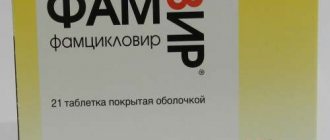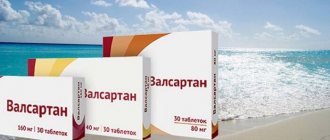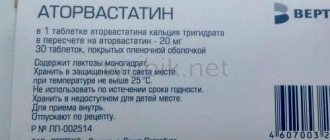Release form and composition
The drug is produced in the form of film-coated tablets, oval, biconvex, almost white or white (in blister packs of 7, 10, 14 or 15 pcs., in a cardboard box instructions for use of Fenofibrate Canon and 4, 12, 14 packs of 7 tablets, or 1,2, 3, 5, 6, 9, 10 packs of 10 tablets, or 2, 6, 7 packs of 14 tablets, or 2, 4, 6 packs of 15 tablets).
Composition of 1 tablet:
- active ingredient: fenofibrate – 145 mg;
- auxiliary components: magnesium stearate, microcrystalline cellulose, colloidal silicon dioxide, mannitol, croscarmellose sodium, povidone K-30, corn starch;
- film coating: Opadry II [talc, polyvinyl alcohol, titanium dioxide, macrogol (polyethylene glycol 4000)].
Fenofibrate's analogs
1. Preparations with a similar composition:
- Traikor;
- Lipantil;
- Ciprofibrate;
- Exlip;
- Trilipix.
2. Preparations with a different active ingredient, but with a similar effect:
- Atorvakor;
- Tulip;
- Storvas;
- Livostor.
Pharmacological properties
Pharmacodynamics
Structurally, fenofibrate is a derivative of fibric acid. Its ability to reduce lipid levels in the body is mediated by activation of PPAR-alpha (alpha receptors).
Under the influence of the drug, PPAR-alpha is activated. As a result, lipoprotein lipase activity increases and the synthesis of apoprotein C-III (ApoC-III) decreases, due to which lipolysis increases and the removal from plasma of atherogenic lipoproteins with a high content of triglycerides (TG) increases. In addition, activation of PPAR-alpha stimulates the synthesis of apoproteins AI (ApoA-I) and A-II (ApoA-II).
When taking Fenofibrate Canon, the content of low-density lipoproteins (LDL) and very low-density lipoproteins (VLDL), including apoprotein B (ApoB), decreases. Also, under the influence of the drug, the content of high-density lipoproteins (HDL), including ApoA-I and ApoA-II, increases.
Given the ability of the active substance to disrupt the synthesis and catabolism of VLDL, Fenofibrate Canon also increases the clearance of LDL. It reduces the content of small dense LDL particles in patients with an atherogenic lipid phenotype and patients at risk for coronary heart disease with lipid abnormalities. Clinical studies have found that fenofibrate reduces the concentration of total cholesterol (TC) by 20–25% and TG levels by 40–55% in the case of an increase in HDL by no more than 30%. In patients with hypercholesterolemia, accompanied by a decrease in LDL by 20–35%, fenofibrate is able to reduce the ratios of TC/HDL, LDL/HDL and ApoB/ApoA-I, which are markers of a high atherogenicity ratio.
Due to the significant effect of the drug on the concentration of LDL and TG, Fenofibrate Canon is effective for hypercholesterolemia, including those accompanied by hypertriglyceridemia, including secondary hyperlipoproteinemia, for example, accompanying type 2 diabetes mellitus. Fenofibrate can significantly reduce and even completely eliminate tuberous and tendinous xanthomas (extravascular cholesterol deposits). With elevated fibrinogen levels, Fenofibrate Canon significantly reduces this indicator, similar to the effect in patients with elevated lipoprotein levels. In individuals receiving the drug, other markers of inflammation, such as C-reactive protein, also decrease.
For hyperuricemia and dyslipidemia, the drug has another positive effect - a uricosuric effect, causing a decrease in the concentration of uric acid by approximately 25%.
In experimental animal studies and clinical studies, Fenofibrate Canon has also been found to attenuate platelet aggregation caused by drugs such as epinephrine, adenosine diphosphate and arachidonic acid.
Pharmacokinetics
The drug Fenofibrate Canon contains a micronized active substance, which has higher bioavailability. In its original form, the active ingredient is not detectable in blood plasma. The main plasma metabolite is detected - fenofibric acid.
The main pharmacokinetic parameters of fenofibrate:
- absorption: fenofibrate is quickly absorbed into the blood after oral administration, reaching maximum plasma concentrations within 4–5 hours. With long-term treatment, plasma concentrations remain stable. If the drug is taken simultaneously with food, absorption of the substance is enhanced;
- distribution: the main plasma metabolite is highly (at least 99%) bound to plasma albumin;
- metabolism: only fenofibric acid is found in its pure form in plasma. It is not involved in microsomal metabolism and is not a substrate for the CYP3A4 isoenzyme. The half-life of fenofibric acid is approximately 20 hours;
- Excretion: Fenofibrate is excreted from the body by the kidneys primarily in the form of the main plasma metabolite and in the form of a glucuronide conjugate. Within 6 days after administration, the drug is excreted almost completely. In elderly people, the total detectable clearance of fenofibric acid does not change.
With long-term use, Fenofibrate Canon does not accumulate in the body. It is not excreted during hemodialysis.
Indications for use
Fenofibrate Canon is prescribed in combination with diet therapy in the following cases:
- severe hyperglyceridemia (dyslipidemia types IV and V according to Fredrickson) - to reduce the concentration of TG;
- primary hyperlipidemia and mixed dyslipidemia (type IIa, IIb, III, IV according to Fredrickson) - to reduce total cholesterol, increased concentrations of LDL, TG and Apo-B, as well as to increase HDL levels;
- mixed dyslipidemia (Fredrickson type IIa, IIb) in patients with coronary heart disease or a high risk of its development (diabetes mellitus, abdominal aortic aneurysm, peripheral arterial atherosclerosis, symptomatic carotid atherosclerosis, or the presence of multiple risk factors corresponding to a 10-year risk of developing coronary heart disease complications more than 20%) - to reduce TG and increase HDL. In this case, Fenofibrate Canon is prescribed in combination with statins - HMG-CoA (3-hydroxy-3-methylglutaryl-coenzyme A) reductase inhibitors.
Indications and restrictions
The drug is prescribed to reduce the level of triglycerides and low-density cholesterol in the following pathologies:
- Primary hyperlipidemia.
- Mixed dyslipidemia. It often develops with the following diseases:
diabetes;- atherosclerotic processes in peripheral or carotid arteries;
- abdominal artery aneurysm;
- other coronary complications. The drug is often used in combination with statins to reduce triglycerides and increase HDL (good cholesterol) levels.
ischemia;
The duration and regimen of treatment is determined by the attending physician. Before prescribing the medicine, you should make sure that the patient does not have the following contraindications:
- individual intolerance to the components that make up the medicine;
- severe renal failure;
- hypersensitivity to fibrates and Ketoprofen;
- obstruction of the gallbladder;
- chronic or acute pancreatitis (except that caused by hypertriglycyridemia);
- childhood and adolescence;
- GW period;
- pregnancy;
- liver dysfunction (cirrhosis).
Cirrhosis
The drug has not been tested on small children, pregnant women and nursing mothers. Therefore, the potential risk for these populations is unknown. Since fenofibrate can cross the placenta and into breast milk, it is not recommended for use so as not to harm the baby.
The drug is used with extreme caution and under the supervision of a doctor for hypothyroidism, renal pathologies, as well as for the treatment of elderly patients and people who abuse alcoholic beverages.
Contraindications
Absolute:
- history of gallbladder disease;
- severe renal failure [creatinine clearance (CC) < 20 ml/min];
- liver failure, including persistent liver dysfunction of unknown etiology and biliary cirrhosis;
- development of photosensitivity or phototoxicity during previous treatment with ketoprofen or fibrates;
- acute or chronic pancreatitis, with the exception of an acute condition caused by severe hypertriglyceridemia;
- age under 18 years;
- lactation period;
- hypersensitivity to any component of the drug.
Relative (Fenofibrate Canon tablets should be taken with extreme caution, after a careful assessment of the benefit-risk ratio):
- hypothyroidism;
- renal dysfunction with CC > 20 ml/min;
- alcohol abuse;
- elderly patients with a history of hereditary muscle diseases;
- simultaneous use of HMG-CoA reductase inhibitors or oral anticoagulants;
- pregnancy period.
Fenofibrate Canon, instructions for use: method and dosage
Fenofibrate Canon film-coated tablets should be taken orally, swallowed whole during meals.
Adult patients are prescribed 1 tablet once a day. Patients receiving fenofibrate 200 mg capsules can be switched to Fenofibrate Canon 145 mg tablets without dose adjustment.
It is prohibited to exceed the dose. For elderly patients, the dosage regimen is not changed.
Treatment with the drug is long-term and should be carried out against the background of standard diet therapy, which was prescribed by a doctor before prescribing Fenofibrate Canon.
Side effects
The following side effects have been reported during the use of fenofibrate (by frequency they are classified as follows: very often - > 10% of cases, often - from > 1% to < 10%, infrequently - from > 0.1% to < 1%, rarely – from > 0.01% to < 0.1%, very rarely – < 0.01%):
- from the digestive tract: often – moderate flatulence and diarrhea, nausea, vomiting, abdominal pain; uncommon – pancreatitis;
- from the hepatobiliary system: often – a moderate increase in the concentration of serum transaminases; uncommon – formation of gallstones; very rarely - hepatitis (first symptoms - itching, jaundice);
- from the respiratory system: very rarely - interstitial pneumopathy;
- from the musculoskeletal system: rarely - muscle weakness, muscle spasm, myositis, diffuse myalgia; very rarely - increased activity of creatine phosphokinase, rhabdomyolysis;
- from the central and peripheral nervous system: rarely – headache, sexual dysfunction;
- from the circulatory and lymphatic systems: rarely - increased levels of hemoglobin and leukocytes;
- vascular disorders: infrequently - venous thromboembolism (deep vein thrombosis, pulmonary embolism);
- on the part of the skin and subcutaneous fat: infrequently - itching, urticaria, rash, photosensitivity reactions; rarely - alopecia; very rarely - photosensitivity, accompanied by erythema, the formation of nodules/blisters on areas of the skin exposed to sunlight or UV light;
- laboratory data: infrequently - increased concentrations of urea and creatinine in the blood serum.
Side effects of the drug Fenofibrate
Extremely rare (no more than 2–4%) mild dyspeptic symptoms, skin allergic reactions, increased transaminase activity in the blood serum, myalgia. Long-term clinical observations (up to 6 years) did not reveal cases of gallstone disease while taking fenofibrate. However, taking into account the presence of such a side effect as a result of taking other lipid-lowering drugs of the fibrate group (clofibrate), the possibility of developing a similar pathology in some patients taking fenofibrate for a long time cannot be completely excluded.
special instructions
Fenofibrate Canon should be prescribed after appropriate treatment aimed at eliminating the cause of secondary hypercholesterolemia, for example, hypothyroidism, uncontrolled type 2 diabetes mellitus, dysproteinemia, nephrotic syndrome, obstructive liver disease, alcoholism, complications of drug therapy.
The effectiveness of the treatment is assessed by the content of total cholesterol, TG, and LDL in the blood serum. If no improvement is noted after several months (usually three) after starting the drug, the doctor will consider the advisability of prescribing alternative or concomitant therapy.
In patients with hyperlipidemia who are taking hormonal contraceptives or estrogen preparations, before prescribing Fenofibrate Canon, it is necessary to determine the nature of the development of hyperlipidemia (primary or secondary), since estrogens can cause an increase in lipid concentrations.
Pancreatitis
There are rare cases of pancreatitis developing during treatment with fenofibrate. Supposed causes of this complication:
- direct exposure to fenofibrate;
- insufficient effectiveness of Fenofibrate Canon in patients with severe hypertriglyceridemia;
- secondary phenomena caused by the formation of sediment or the presence of stones in the gall bladder, which is accompanied by obstruction of the common bile duct.
Musculoskeletal system
Lipid-lowering drugs can have toxic effects on muscle tissue. Rare cases of the development of such a severe complication as rhabdomyolysis have been described. The risk of its occurrence increases in patients with hypoalbuminemia and renal failure, including a history of it.
It is necessary to suspect a toxic effect on muscle tissue if the patient develops the following disorders: myositis, muscle weakness, diffuse myalgia, muscle spasms, cramps, a marked increase in creatine phosphokinase activity ≥ 5 times the upper limit of normal. Fenofibrate Canon is canceled in this case.
The risk of rhabdomyolysis may also be increased in patients predisposed to myopathy and/or rhabdomyolysis. This group includes people over 70 years of age, patients with hypothyroidism, kidney dysfunction, a history of hereditary muscle diseases, and alcohol abusers. For patients at risk, Fenofibrate Canon is prescribed only if the expected benefit of therapy significantly outweighs the potential risk of developing rhabdomyolysis.
When taking HMG-CoA reductase inhibitors or other fibrates together, the risk of dangerous toxic effects on muscle fibers increases, especially with concomitant muscle diseases. For this reason, Fenofibrate Canon, together with these drugs, is prescribed only to patients with severe mixed dyslipidemia and high cardiovascular risk, provided there is no history of muscle diseases. Treatment in this case is carried out under particularly close medical supervision with regard to the timely detection of signs of the toxic effect of the drug on muscle tissue.
Liver function
Lipid-lowering drugs may increase the activity of hepatic transaminases. As a rule, this disorder is temporary, mildly expressed and asymptomatic. However, during the first 12 months of taking Fenofibrate Canon, it is recommended to check transaminase activity every 3 months. If their concentration increases, careful medical supervision is required. If alanine aminotransferase and aspartate aminotransferase levels increase ≥ 3 times the upper limit of normal, the lipid-lowering agent should be discontinued.
Renal function
Fenofibrate Canon, used both in combination with statins and as a single drug, can reversibly increase serum creatinine concentrations. However, this disorder is stable throughout the entire treatment period. With long-term therapy, no further increase in the indicator was observed. After discontinuation of the drug, the concentration returned to its original values. The clinical significance of such changes has not been established.
When treating patients with renal failure with Fenofibrate Canon, it is recommended to monitor renal function. Special monitoring is required for persons at risk of developing renal failure: elderly people and patients with diabetes mellitus. If, while taking the drug, the creatinine concentration increases by 2 times or more from the upper limit of normal, therapy is stopped. It is recommended to determine the creatinine concentration during the first three months after starting the drug, as well as periodically after its discontinuation.
Impact on the ability to drive vehicles and complex mechanisms
There was no negative effect of Fenofibrate Canon on the acuity of visual perception, reaction speed and ability to concentrate.
Use during pregnancy and lactation
In experimental studies conducted on animals, fenofibrate did not have a teratogenic effect. Embryotoxicity has been noted in preclinical trials at doses that are also toxic to the mother. In this regard, the exact risk for humans has not been established, therefore Fenofibrate Canon is prescribed to pregnant women if the expected benefits of treatment are higher than the potential risks.
During lactation, a lipid-lowering drug is contraindicated due to insufficient data on its safety for the child if the mother takes fenofibrate during this period.
Terms of sale and storage
To purchase at a pharmacy, you need to show a doctor's prescription. The following security requirements apply:
- the room temperature should not exceed 25 degrees;
- choose a place where direct sunlight and moisture do not penetrate.
If you have a child, it is important to protect him from free access to medications.
The shelf life is 2 years; after expiration, the remaining tablets cannot be used; they are discarded.
Drug interactions
- oral anticoagulants: their effect is enhanced, the risk of bleeding increases (since fenofibrate displaces the anticoagulant from the sites of binding to plasma proteins). Patients who received anticoagulants should reduce their dose by approximately ⅓ at the beginning of the use of Fenofibrate Canon, and then the dose is gradually adjusted under the control of the level of the International Normalized Ratio (INR);
- statins and other fibrates: the risk of dangerous toxic effects on muscle fibers increases;
- isoenzymes of the cytochrome P450 system: in vitro studies on human liver microsomes have shown that fenofibrate and fenofibric acid are not inhibitors of cytochrome P450 isoenzymes (CYP1A2, CYP2E1, CYP2D6, CYP3A4). At therapeutic concentrations, these compounds weakly inhibit the isoenzymes CYP2A6 and CYP2C19, weakly or moderately inhibit CYP2C9;
- cyclosporine: There are several severe cases of reversible decline in renal function known when using the combination of fenofibrate and cyclosporine, so treatment should be carried out under strict monitoring of renal function. In case of serious changes in laboratory parameters, Fenofibrate Canon should be discontinued.
Overdose and precautions
To date, no cases of overdose have been identified. The instructions indicate that if an overdose is suspected, symptomatic treatment will be required.
The instructions also contain precautions:
- Liver enzymes are monitored every three months in order to promptly identify abnormalities in liver function;
- During the first three months of therapy, creatinine levels are regularly monitored; if the content of the substance increases twice as high as normal, the drug is discontinued;
- Treatment with Fenofibrate is carried out only under the supervision of a doctor and for a long time;
- Additionally, the patient is prescribed a low-fat diet;
- If after 3-6 months the patient’s condition remains unchanged, the doctor decides to change the dosage or select an alternative therapeutic regimen;
- In elderly patients, with pathologies of muscles, kidneys, and addiction to alcohol, taking the drug can provoke the destruction of muscle cells;
- The simultaneous administration of Fenofibrate and a statin is possible only in case of serious heart pathologies and the absence of any muscle pathologies.
Reviews of Fenofibrate Canon
There are no patient reviews about Fenofibrate Canon on specialized websites and forums.
Various foreign studies have found that fenofibrate, by reducing total cholesterol, can reduce the risks of cardiovascular diseases, stroke and heart attack. In addition, factors such as endothelial dysfunction, inflammation, and vascular remodeling make an important contribution to the development of atherosclerosis (which is a common cause of stroke and heart attack). Fenofibrate activates PPAR-alpha receptors, due to which it has an anti-inflammatory effect, reducing inflammatory markers such as C-reactive protein and interleukin-6. However, it has not yet been established whether the drug can reduce mortality in the described group of patients.
In 2012, scientists at the University of Colorado (USA) in a small clinical study proved that fenofibrate can rejuvenate human blood vessels in just 7 days. By activating PPAR-alpha, the main metabolite (fenofibric acid) enhances the breakdown of fats and increases the removal of triglycerides and LDL (“bad” cholesterol) from the blood. In addition, fenofibric acid reduces the synthesis of ApoC-III, which is also important for blood vessels. Thus, short-term use of fenofibrate in healthy people of different ages can improve vascular endothelial function by reducing oxidative stress, as well as increasing endothelial nitric oxide synthase, an important component involved in the dilation of blood vessels while reducing high blood pressure.





